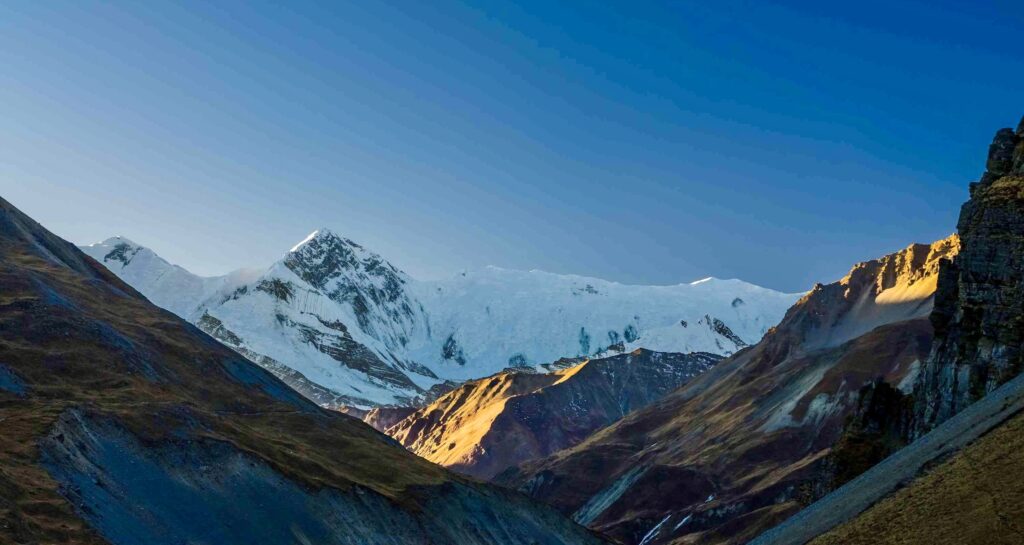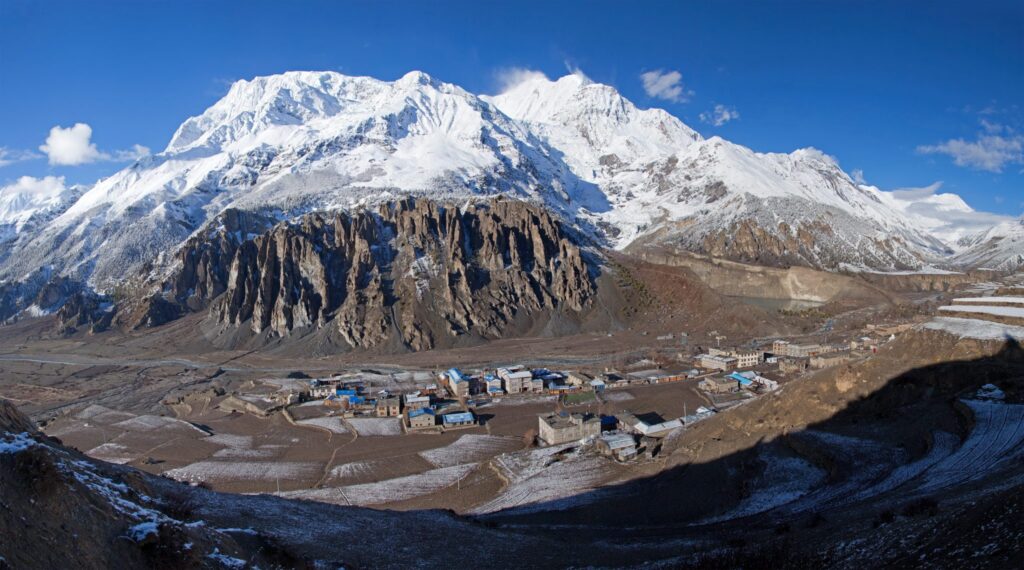Gangapurna Expedition (7,455 m)
- Home
- Gangapurna Expedition (7,455 m)

The Gangapurna Expedition (7,455 m) is one of Nepal’s most remarkable mountaineering adventures, offering climbers a chance to experience the pure essence of high-altitude Himalayan climbing in the spectacular Annapurna Region. Located just south of Annapurna III, Mount Gangapurna rises majestically above the Manang Valley, presenting a thrilling combination of steep ice faces, technical rock sections, and breathtaking alpine scenery.
For climbers seeking an authentic Himalayan challenge away from crowded routes, Mt. Gangapurna provides a perfect balance of adventure, technicality, and natural beauty — making it a favorite among seasoned mountaineers.
The Gangapurna Expedition begins in the vibrant city of Kathmandu, where climbers prepare for the ascent and attend briefings led by our professional climbing guides. The journey continues through Besishahar, Chame, and Manang, following part of the legendary Annapurna Circuit Trail.
Once acclimatized, climbers establish Gangapurna Base Camp (4,600 m), which serves as the launch point for the summit push. The climbing route follows steep ice and snow slopes, demanding solid mountaineering skills, good physical conditioning, and high-altitude experience. From the summit, the panoramic views of Annapurna I, III, Tilicho Peak, Gangapurna Glacier, and the Manang Valley are simply unforgettable.
Day 01: Arrival in Kathmandu – Transfer to hotel and pre-expedition briefing.
Day 02: Rest and expedition preparation day in Kathmandu.
Day 03: Drive from Kathmandu to Besishahar (823m) – 6 hrs.
Day 04: Drive from Besishahar to Chame (2,670m) – 5 hrs.
Day 05: Trek from Chame to Pisang (3,100m) – 5–6 hrs.
Day 06: Trek from Pisang to Manang (3,540m) – 6–7 hrs.
Day 07: Acclimatization and rest day in Manang – short hikes and exploration.
Day 08: Trek from Manang to Gangapurna Base Camp (4,600m) – 5 hrs.
Days 09–27: Climbing period – Base Camp setup, acclimatization rotations, and final summit attempt of Mt. Gangapurna (7,455m).
Day 28: Return trek from Base Camp to Manang (3,540m).
Day 29: Trek to Thorong Phedi (4,420m).
Day 30: Cross Thorong La Pass (5,416m) and descend to Muktinath (3,802m).
Day 31: Trek from Muktinath to Jomsom (2,700m) via Kagbeni.
Day 32: Flight from Jomsom to Pokhara (950m).
Day 33: Drive or fly back to Kathmandu.
Day 34: Leisure day in Kathmandu – souvenir shopping or optional city tour.
Day 35: Final departure – transfer to the airport.
Climbing Mt. Gangapurna (7,455 m) demands not only physical and technical preparation but also careful timing. Choosing the right season is crucial for a successful and safe expedition. The best time for the Gangapurna Expedition is during Spring (April to May) and Autumn (September to October) — the two main mountaineering seasons in Nepal.

Both seasons provide favorable weather, stable snow conditions, and clear visibility — essential elements for high-altitude climbing and scenic trekking in the Annapurna region.
The Spring season is widely regarded as the best time for the Gangapurna Expedition. This period marks the end of the winter snowfalls and the beginning of warmer, more stable conditions in the high Himalayas.
The skies are generally clear, offering excellent mountain visibility, and the snowpack stabilizes, reducing avalanche risks on major climbing routes.
The Autumn season is the second-best time for the Gangapurna Expedition and equally popular among climbers seeking stable post-monsoon conditions. After the summer monsoon clears, the Himalayan atmosphere becomes crisp and visibility outstanding.
While the Spring and Autumn seasons are ideal, it’s important to understand why other times of the year are not recommended for Gangapurna climbing.
| Season | Duration | Weather Condition | Visibility | Temperature | Remarks | |
|---|---|---|---|---|---|---|
| Spring | April–May | Stable, mild, dry | Excellent | -20°C to +20°C | Best for climbing and clear weather | |
| Autumn | Sept–Oct | Dry, stable, crisp | Excellent | -15°C to +18°C | Perfect post-monsoon visibility | |
| Winter | Dec–Feb | Extremely cold, snowy | Moderate | -25°C to -5°C | Not recommended | |
| Monsoon | June–Aug | Wet, unstable, cloudy | Poor | 0°C to +25°C | Not suitable |
The best time for the Gangapurna Expedition is Spring (April–May) and Autumn (September–October) — when weather patterns are most stable, the skies are clear, and climbing routes are safest. These windows provide the best balance of comfort, safety, and summit success.
Climbing Mt. Gangapurna (7,455 m) is more than reaching a summit — it’s a test of endurance, teamwork, and the spirit of Himalayan exploration. From the peaceful trails of Manang to the technical ascents above Base Camp, every step is filled with challenge and reward.
For mountaineers seeking a technical 7,000-meter climb in the Annapurna Range, this expedition promises a life-changing experience that blends adventure, culture, and nature at its finest.
If you need any further information, please feel free to contact us via email at [email protected] or by phone/WhatsApp at +977-9851013072.
A: Mount Gangapurna is located in the Annapurna region of Nepal, nestled between Annapurna III and Tilicho Peak. It lies close to the beautiful Manang Valley, offering incredible views of the surrounding Himalayan giants such as Annapurna II, Annapurna IV, and Chulu Peaks.
A: The Gangapurna Summit stands at 7,455 meters (24,459 ft) above sea level, making it one of the prominent 7,000-meter peaks in the Annapurna Himalayan Range.
A: The best time to climb Mount Gangapurna is during the spring (March to May) and autumn (September to November) seasons.
Spring Season (March–May): Offers stable weather, clear skies, and moderate temperatures—ideal for climbing.
Autumn Season (September–November): Known for crisp air, clear visibility, and excellent summit success rates.
Both seasons provide favorable climbing conditions, breathtaking mountain views, and safer routes.
A: The Gangapurna Expedition is considered a technically challenging climb, suitable for experienced mountaineers. It involves steep ice and snow sections, mixed rock climbing, and high-altitude exposure. Prior experience in high-altitude climbing (above 6,000m) and familiarity with technical gear such as crampons, ice axes, and ropes are essential.
A: Yes. The Gangapurna Expedition is not suitable for beginners. Climbers should have:
A: The full expedition typically lasts around 35 days, including trekking, acclimatization, and summit climbing. The itinerary also includes travel days between Kathmandu, Manang, and Pokhara.
A: The standard route begins in Kathmandu, followed by a scenic drive to Besishahar and Chame, then trekking through Pisang and Manang. The Gangapurna Base Camp (4,600m) is established above Manang, serving as the main climbing base before heading toward Camp I, Camp II, and Camp III en route to the summit.
A: Generally, climbers establish three higher camps:
A: Accommodation includes:
A: Climbers require the following permits:
A: Essential climbing gear includes:
A: You should have excellent physical conditioning, capable of trekking 6–8 hours daily with a backpack and climbing at high altitudes. Training should include aerobic fitness, strength training, and altitude simulation if possible. Mental resilience and previous high-altitude experience are key to success.
A: Yes, altitude sickness is always a risk above 3,000 meters. Proper acclimatization, hydration, and gradual ascent are vital. The itinerary includes multiple acclimatization days, and our guides are trained in first aid and high-altitude medicine. Supplemental oxygen and a Gamow bag are available for emergencies.
A: The climb is led by a licensed and experienced climbing Sherpa, supported by a professional trekking and base camp team. All guides are certified by the Nepal Mountaineering Association (NMA) and have extensive experience in 7,000m and 8,000m Himalayan expeditions.
A: You can easily book through Nepal Treks and Tour’s official website or contact us directly via email or WhatsApp. Our expedition experts will guide you through trip customization, permit processing, and gear preparation to ensure a smooth and safe adventure.
PRICE INCLUDE |
|
|---|---|
PRICE EXCLUDE |
|
Arrive at Tribhuvan International Airport, where our representative will warmly welcome you and transfer you to your hotel. In the evening, attend a pre-trip briefing with your expedition leader to review the plan, equipment, and safety protocols.
Write Your Review